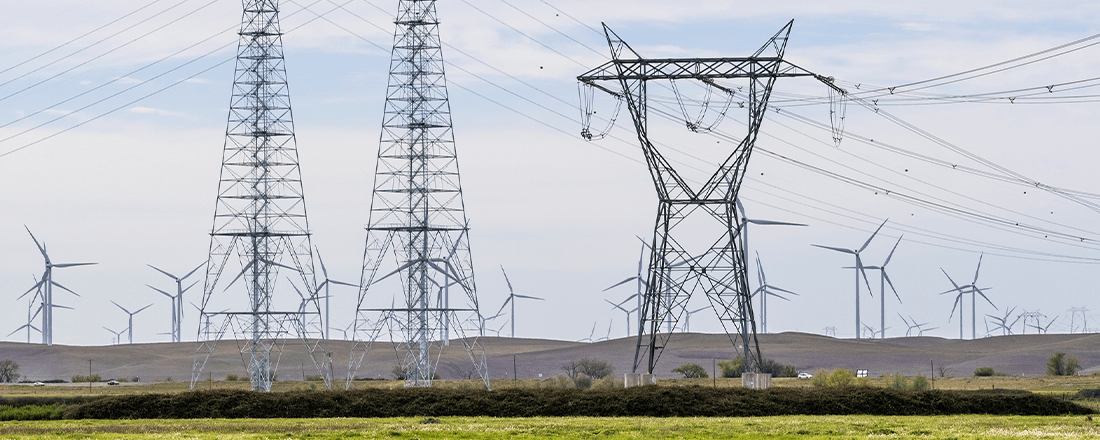California is at the forefront of tackling climate change, with groundbreaking policies such as achieving 100% zero-carbon and renewable energy by 2045 (SB 100, 2018), and transitioning to exclusively zero-emission new car sales by 2035 (Executive Order N-79-20). According to the California Air Resources Board, achieving these goals will require tripling the grid’s current clean energy capacity by 2045. As California’s first Community Choice agency, MCE continues to set the statewide bar, boasting over 95% greenhouse gas-free energy as of 2022, decades ahead of state goals. The critical question now is: how can we ensure our power grid is sufficiently equipped and resilient to handle this significant transformation to meet the soaring demand anticipated in the coming years?
Revamping an Outdated System
California’s energy landscape is evolving. Originally built to distribute electricity from fossil fuels, our power grid is now shifting to integrate renewable sources. In the past two decades, California has significantly increased its renewable energy capacity, particularly in solar, marking a major move towards a greener, more robust power system.
However, solar energy alone isn’t enough. It’s a powerful resource but intermittent. To ensure reliability and meet our electrification needs, we’re focusing on balancing the energy supply. This involves incorporating a mix of intermittent renewables like solar and wind, as well as baseline renewables like geothermal and biogas, which can provide consistent energy output. Strategic load shifting, especially to align energy usage with solar availability, is key in this next phase of energy innovation.
Innovative Solutions for a Future-Ready Grid
To address the challenges of integrating renewable energy sources, MCE is implementing several key solutions:
1. Smart EV Charging & Grid Technologies
The MCE Sync app helps EV drivers charge their vehicles when clean energy is abundant and costs are low. Advancements in smart grid technologies, including smart meters and grid automation, are important to achieving efficient electricity distribution and demand forecasting.
2. Demand Response Programs
Programs like MCE’s Peak FLEXmarket incentivize customers to reduce electricity use during the periods of highest electricity demand to improve grid reliability. They also support the California Independent System Operator’s Flex Alerts, which encourage voluntary conservation during peak demand.
3. Workforce Development for Grid Modernization
Expanding and investing in the green workforce is core to MCE’s mission and vital for building new infrastructure and integrating smart technologies to boost the grid’s capacity and resilience.
4. Distributed Energy Resources
The integration of distributed energy resources, like solar panels paired with battery storage, reduces the burden on central grid infrastructure, improving grid reliability and flexibility. Virtual power plants (VPPs) harness these resources to support the grid, turning clean energy technologies on and off as needed to help reduce strain during high-demand times and supply power back onto the grid when needed.
Embracing Regional Grid Integration
The California Independent System Operator (CAISO), along with retail electricity suppliers, are focusing on regional grid integration to advance our decarbonized future. This approach involves consolidating multiple smaller power grids into a larger, unified grid, across state lines, enhancing resilience and efficiency.
- Expanding Import and Export Capacity: By tapping into the broader Western electricity market, California can expand its capacity to import and export clean energy. This connection allows the state to access a wider variety of clean energy sources, including hydroelectric power from the Pacific Northwest and solar energy from the Southwest. Additionally, California can export surplus solar energy to other states.
- Stabilizing Energy Costs and Enhancing Reliability: Regionalization helps stabilize energy costs and provides protection against outages. Accessing different power resources allows California to meet varying energy needs throughout the day and year, reinforcing the state’s energy security and contributing to a more resilient regional ecosystem.
- Addressing Challenges: While regional grid integration offers significant benefits, it also presents challenges such as regulatory coordination and infrastructure compatibility. Careful planning and collaborative efforts are essential to overcome these obstacles, making regionalization a key tool in California’s clean energy strategy to achieve renewable energy goals efficiently.
Addressing Transmission and Distribution Development Needs
The current T&D system requires significant upgrades to handle the influx of renewable energy. Investor-Owned Utilities like PG&E are responsible for these upgrades. Key areas of focus include:
- Enhancing Transmission Capacity to transport renewable energy efficiently over long distances.
- Modernizing Distribution Networks to handle the two-way flow of electricity and integrate smart grid technologies for real-time management.
- Investing in Grid Resilience against natural disasters and cyber threats through physical upgrades and cybersecurity measures.
The Bottom Line: Paving the Path to an Electrified Future
While electrification presents challenges, California has a proactive approach using technology, policy, and infrastructure investments to ensure that the grid not only survives but also thrives in an electrified future. By working together to address these challenges, we move one step closer to a sustainable and reliable energy future for all.






